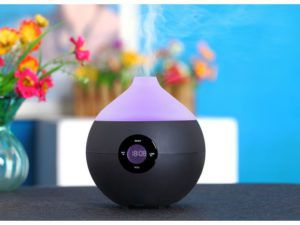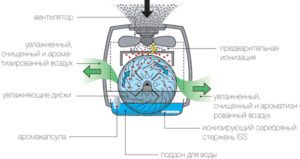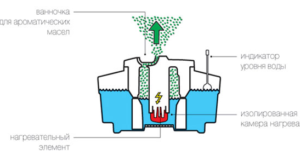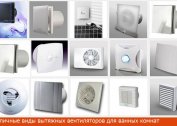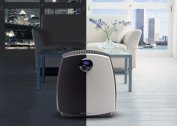Comfortable working and living conditions are primarily associated with the technological achievements of civilization: from a household washing machine and a refrigerator to central heating radiators and industrial units.
The work of all heat and electrical appliances that provide residential, and non-residential space with the necessary level of ergonomics, is accompanied by negative phenomena - a decrease in humidity and positive ionization of the air.
It is these indicators that affect the well-being, and with constant exposure, and on human health.
The effect of ions on health and humidity
Ionization is the process of changing neutral particles into ions (positive and negative), which occurs both under the influence of artificial technological factors and as a result of natural phenomena.
Positive "heavy" ions, namely, their separation is accompanied by the operation of electrical equipment, have a negative effect on a person, causing fatigue, oxygen starvation and, as a result, headaches, problems with breathing and pulse.
The most favorable are negative ions (“lungs”), which enrich the air with oxygen and thus provide maximum comfort for the environment.
Technical regulation standards that establish safety standards for modern buildings and structures provide for a minimum limit of negative particles in a room at 600 ions per 1 cubic centimeter. Measurements in residential apartments give depressing results: not more than 100 ions / cubic meter. cm.
The optimal indicators for human health are at the level of 3000 to 5000 ions / cu. cm.
Given that positive ions are generated continuously, the necessary level of “light” ions can only be achieved by artificial ionization.
Operating devices, not only heating, but also electrical, create the conditions under which the process of increasing positive ions occurs in a room, but humidity decreases as well.
The optimum humidity level is accepted in the range of 40-60%. In winter, indoor humidity decreases in proportion to outdoor temperature: at -20 ° C, measurements show about 5% of the moisture inside. To maintain optimal indoor performance, a humidifier is recommended.
Types of humidifiers with ionization
The constant evaporation of moisture by the human body, the operation of electrical appliances and heating systems force us to look for the possibility of increasing humidity to the minimum necessary level, preferably with the neutralization of positive "heavy" ions. At the moment, there is a technical possibility to combine hydration with ionization.
Produced varieties of such equipment are divided into several types:
- traditional, based on the use of natural evaporation of moisture from the surface of porous materials;
- steam, working on the principle of converting water into steam under the influence of high temperatures;
- ultrasonic, one of the most modern technologies, allowing to achieve micro-dispersed suspension of moisture in the air.
They are equipped with special generators of negative ions. Most often, the ionizer built into household appliances works by the principle of corona discharge. Although there is also the possibility of enriching space using radioactive or ultraviolet radiation.
During operation, it provides an optimal level of anions, and is not necessarily accompanied by the smell of ozone.
Porous or traditional
The design is based on moisturizing cartridges, which are a porous material saturated with water. Air masses are pumped through them by a fan. Previously, they pass through a number of filters that act as a cleaner for dust and other suspensions.
The design is not overloaded with additional sensors and regulators, due to the natural evaporation process: the higher the humidity in the environment, the less moisture evaporates from the surface of the cartridge. In addition, the temperature affects the level of humidity: in a hot room, evaporation will be more intense.
One of the varieties of porous technology is the so-called “air washing”. In this case, the fan pumps air not through humidifying cartridges, but onto hydrophilic disks placed on a special drum that rotates along the horizontal axis. Discs during rotation are immersed in a tank of water, which is then evaporated under the pressure of the stream from the fan. Equipped with an electric discharge, it will simultaneously carry out the function of cleaning the air masses and enriching them with ions.
Steam
The principle of operation is based on the formation of steam by heating water to a boiling state.
They are divided into two types:
- boilers;
- steam.
At the same time, a boiling kettle can be considered the simplest boiling humidifier. The principle of operation is the same: under the influence of heating, water boils and begins to evaporate and, thus, saturates the room with moisture.
Steam has a slightly different principle: steam is supplied during ventilation or conditioning to the incoming air masses. In this case, the source of steam can be an autonomous or centralized steam generator.
It is without fail equipped with a special automatic sensor - a hygrostat for humidity control. They are rarely used in everyday life, due to the fact that boiling water increases the temperature in the room.
Ultrasonic
The most popular technology, which easily combines a humidifier, a cleaner and an ionizer in one design.
Moisture dispersion to the level of microparticles is achieved by the impact of an ultrasonic wave on the surface of a tank of water. The resulting fog is spread by a directed flow of a fan built into the device.
This design provides:
- creating fog without heating the space;
- increase in humidity to the necessary level (a gyrostat allows you to control its level up to 100%);
- acceptable noise level;
- humidity mode programming.
Other species
With the development of technology, rotary and film varieties are outdated. In the first case, it is assumed that the dispersion of water occurs during the rotation of the disk. And in the second - in contact with a moistened flat nozzle.
Injector or nozzle are also no longer used in domestic premises. Dispersion is achieved by mechanical spraying through a nozzle. The result is too large drops of moisture, which, condensing on objects of furniture or equipment, have a bad effect on their functionality and service life.
Injection spraying is widespread in the industrial and agricultural sectors: for example, to moisten greenhouses or vegetable stores.
Ecology and constant stress create a serious burden on the body. Last but not least, air affects health. Modern technologies can improve its composition, clean, saturate with oxygen and moisture. A humidifier in this regard will significantly improve the quality and comfort of life.
